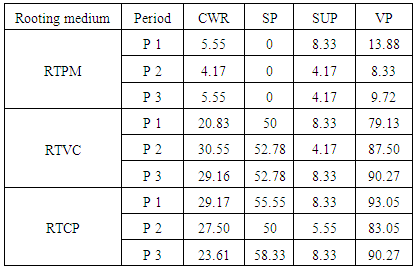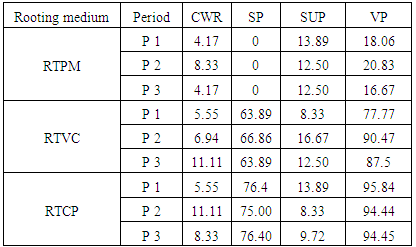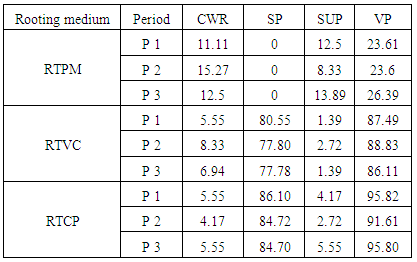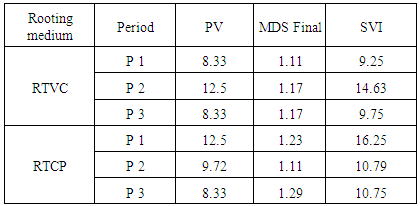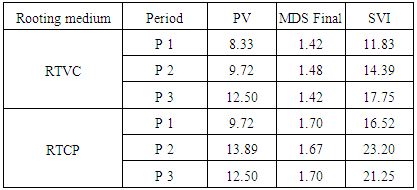-
Paper Information
- Paper Submission
-
Journal Information
- About This Journal
- Editorial Board
- Current Issue
- Archive
- Author Guidelines
- Contact Us
International Journal of Agriculture and Forestry
p-ISSN: 2165-882X e-ISSN: 2165-8846
2015; 5(5): 287-290
doi:10.5923/j.ijaf.20150505.04
IBA Induced Rooting Characteristics in Golden Shower Tree: Evaluation Using SVI Concept
Justin R. Nayagam, Mani Varghese K. I.
Department of Botany, Union Christian College, Aluva, India
Correspondence to: Justin R. Nayagam, Department of Botany, Union Christian College, Aluva, India.
| Email: |  |
Copyright © 2015 Scientific & Academic Publishing. All Rights Reserved.
Rooting of golden shower (Cassia fistula) stem cuttings using three IBA (Indole 3-butyric acid) concentrations 300 ppm, 500 ppm and 1000 ppm IBA, have been carried out and the data obtained were evaluated with SVI (sprouting value index) method in order to interpret the vigorin rooting/sprouting and the suitable medium, which gives maximum results. Field studies were carried out using three rooting medium at a location in Central Kerala, Peninsular India, from February 2012 to October 2014 at four months regular interval. The control cuttings do not recorded rooting. The results obtained indicate high SVI (sprouting value index) (16.25 in 300ppm IBA treatment; 23.20 in 500ppm IBA treatment; 29.17 in 1000ppm IBA treatment),when stem cuttings planted in root trainers with coir pith compost (RTCP) for all the three concentration of IBA applied. Sprouting percentage was increased and the delay in completion of sprouting/rooting initiation decreased by the use of IBA treatment. Increased CWR and SUP percentages indicate defects in management practices, dormancy and or the genotype of the cultivar.
Keywords: Stem cuttings, Sprouting value index, Golden shower tree, Rooting media
Cite this paper: Justin R. Nayagam, Mani Varghese K. I., IBA Induced Rooting Characteristics in Golden Shower Tree: Evaluation Using SVI Concept, International Journal of Agriculture and Forestry, Vol. 5 No. 5, 2015, pp. 287-290. doi: 10.5923/j.ijaf.20150505.04.
Article Outline
1. Introduction
- Plant propagation has a global effect, as it is a fundamental occupation of human kind and its discovery dates back to the origin of civilization and ornamental gardening attained high level during the period between 500 B.C to A.D. 1000 [1], [2]. The vegetative propagation of herbaceous plants can be performed easily as many of them produces bulbs, rhizomes, corms, tubers, offsets, suckers and stolons which are natural vegetative propagating structures. But vegetative propagation in tree species is a difficult process and it is attained through hormone application mostly in stem cuttings, which eventually initiates adventitious root and shoots [3-5]. Again, there are several mathematical expressions and explanations to measure seed germination and viability in sexually reproducing plants [6-10] but mathematical expressions for determining efficiency of vegetative planting material or for clonal propagation is scanty. The data obtained through the present investigation are being interpreted using sprouting value index (SVI).Cassiafistula the golden shower tree is common throughout the Gangetic valley, Central India, Deccan and South India. Besides it is found in Myanmar and Sri Lanka. In Kerala, it occurs in the dry and moist deciduous forests and it is often grown as an ornamental tree [11], [12] or avenue tree [13] with multifarious medicinal importance [14]. The lack of technology for regeneration from cuttings was considered for selecting the plant for the experiment trials.
2. Materials and Methods
2.1. Specimen Collection and Conduct of Field Trials
- For the present investigation plant samples were collected from mother plants grown in the T.C J Memorial Botanical Garden, Union Christian College, Aluvaand from avenue of S. A. Road, Ernakulam. All field trials were conducted in the plant nursery of T.C Joseph Memorial Botanical Garden, of the Department of Botany, Union Christian College, Aluva, (+10° 7' 30.65", +76° 20' 3.32") Ernakulam district, Kerala State, India.For the sake of large scale planting material production in mechanized gardens, trials were conducted in 100cc root-trainer blocks (24 celled) using potting mixture (RTPM), root trainers with vermin compost (RTVC) and root trainers with coir pith RTCP as rooting medium.
2.2. Experiment Design
- For all field trials, average of the three replicates during the months of February (P1), and June (P2), October (P3) from Feb 2012 to October 2014were conducted in three different rooting medium such as root-trainers with potting mixture (RTPM), root trainers with vermi compost mixture (RTVC) and root-trainers with coir pith (RTCP). Stem cuttings with an average size of 7.5 to 10 cm were used. The sample size was kept twenty-four for each trials separately as the 100cc root-trainer block contains 24 cells. A non-auxin control and three Indole 3-butyric acid (IBA) concentrations were designed in this experiment with 300ppm, 500ppm and 1000ppm (parts per million) in order to detect the rooting/sprouting ability by quick dip method. A randomized complete block design was employed. After 45 days, the cuttings were evaluated for rooting/sprouting percentages, mortality percentage and viability percentage. The data obtained were subjected to one factor analysis, employing analysis of variance (ANOVA) and two-way ANOVA.
2.3. Calculation of SVI
- In order to develop the new idea of calculating sprouting value index (SVI), data regarding sprouting and successful rooting percentages (SP – sprouting percentages), percentage of planting material with callus production but without rooting (CWR – callus without rooting), percentage of sound unsproutedpropagule without callus production (SUP) (was determined by vertical cut test: planting material with more than three nodes living tissues was considered viable) was prepared. Viability percentage can be prepared using the formula (VP = SP + CWR + SUP), peak value (PV = maximum mean sprouting recorded at any time during the test), final mean sprouting (final MDS = cumulative percentage of full sprouting at the end of the test divided by number of days to finish sprouting) were calculated. SVI index method developed through the present study is calculated by the equation, SVI = PV * MDS.
3. Results
- Sprouting and rooting studies of stem cuttings were carried out in three different rooting medium during three seasons in an year (June, October and February), for three consecutive year and the various attributes obtained are given in table 1 to table 6. Table 1, table 2 and table 3 gives the VP together with SUP, SP and CWR of rooted stem cuttings of golden shower in three concentrations used against the control whereas table 4, table 5 and table 6 gives SVI in different concentrations. Callus production as well as sprouting and rooting was very poor in control. High VP was obtained with all the three concentrations of IBA used (ranging between 83.05% to 95.84%) in the rooting/ sprouting medium RTCP.
|
|
|
|
|
|
4. Discussions
- The SVI studies worked out in the present study is a mathematical approach to determine the quality of rooting material, suitability of the medium used for rooting and the optimum concentration of IBA to be used. Production of elite genotypes of any plant species can be generated by vegetative method of propagation round the year. Successful propagation using stem cuttings has been reported by several studies in various plants, which uses stem cuttings, rhizomes or other vegetative parts [15-19] but rooting of stem cuttings from tree species is always a difficult job [14]. In field trials, all planting materials gave elite performance in RTCP planting medium. In the trials using 1000ppm IBA (Indole 3-butyric acid) treated cuttings also SVI was highest in RTCP (29.17). Significant differences in rooting were found between various rooting media when effect of rooting, in sheanut cuttings were performed [20]. Sprouting percentage and speed of completion of sprouting/rooting initiation increased by the use of IBA treatment [14]. However, it is shown by other workers [20] that very high IBA concentration have negative effect in rooting. Comparing the CWR and SUP percentages one can also assess the defects in management practices, dormancy and the genotype of the cultivar.Sprouting index value (SVI) proposed through the present study is a modified form of Germination value (GV), proposed by Czabator [6] for seed germination studies. It is also suitable in field and nursery trials for vegetative propagation and IBA treated rooting of cuttings. The incorporation of CWR (callus production without rooting) along with SUP (sound unsproutedpropagule) in calculating VP (Viability percentage) is effective in finding the field oriented defects. SVI and VP is an integrated measure of planting material quality. The speed of sprouting/rooting ability along with the completeness of sprouting can also be determined vegetative planting materials. Suitable rooting media hold considerably high rooting ability [14] [20].Even though SVI for control were found zero, the VP for all the IBA treated trials are > 90% (table 1, table 2 and table 3) which indicates that by using alternate methods like pretreatments and management practices, SVI can be increased. The internal physiology of the planting material may be the reason for the same. The change in planting material and IBA treatment used affects the rooting process as in the present study; SP was increased in higher concentration (1000ppm IBA). Methods for reducing CWR and SUP values can increase SP and the sample in rooting medium with least difference in SP and VP value will give maximum performance. Results of the rooting experiments showed that with very high IBA concentration in sheanut tree cuttings, rooting ability decreased [20] and hence three concentrations of IBA were used in the present experiment.
5. Conclusions
- The present study focuses on regeneration of plantlets from stem cuttings of Golden shower tree (Cassia fistula)and the data obtained were interpreted using sprouting value index (SVI) to establish suitable vegetative planting material and suitable rooting medium through field trials. Trials conducted in different rooting medium reveal the sprouting efficiency and vigor in different medium. SVI is a statistically treated data, which is obviously a modification of germination value for seed germination proposed by Czabator [6] the incorporation of CWR (callus production without rooting) along with SUP (sound unsproutedpropagule) in calculating VP (Viability percentage) makes it suitable for vegetative cultivation practices and it interprets the quality of planting material, failure due to management practices and the selection of suitable rooting medium. This method of planting stock preparation is valuable in large-scale cultivation and much promising in producing quality clonal planting material production in economically important plants in future.
ACKNOWLEDGEMENTS
- The author expresses his heartfelt gratitude to Dr. A Benny Cherian, Principal, Union Christian College, Aluva and Dr Thara K. Simon Head of the Botany Department, for providing space to conduct field trials in the Dr. T.C Joseph Memorial Botanical Garden, Department of Botany, Union Christian College, Aluva. Thanks to Mr. Thomachen, Gardener, Dr. T.C Joseph Memorial Botanical Garden, Department of Botany, Union Christian College, Aluva, for maintaining the field specimens throughout the study period. Extending a word of thanks to Mr. Jabir who helped in statistical correlation.
 Abstract
Abstract Reference
Reference Full-Text PDF
Full-Text PDF Full-text HTML
Full-text HTML